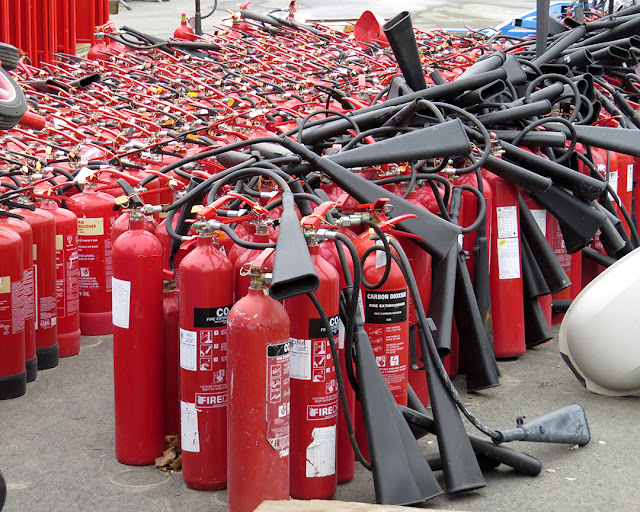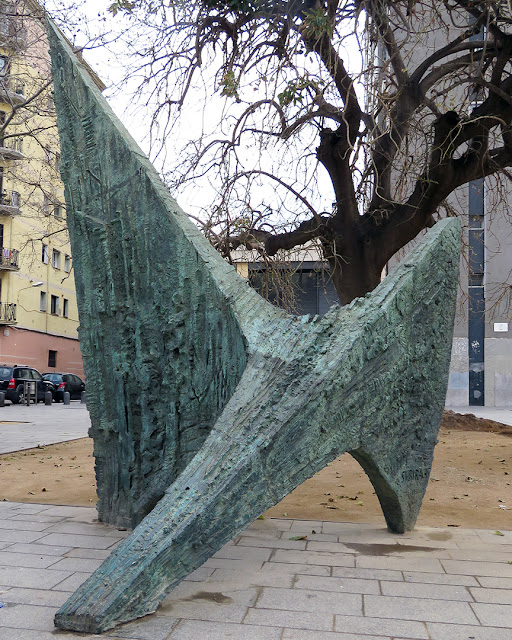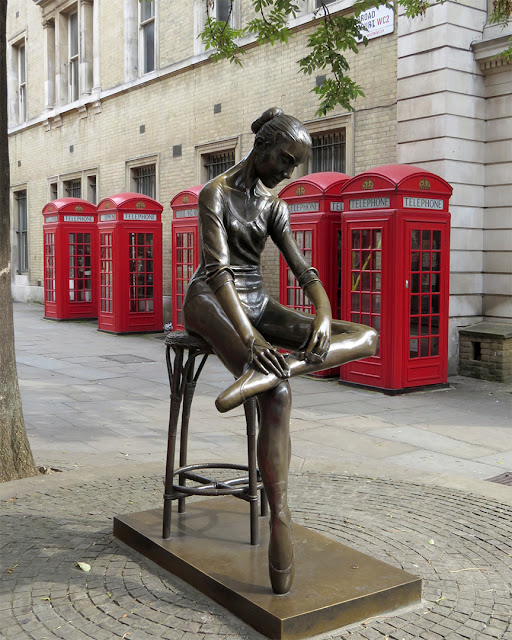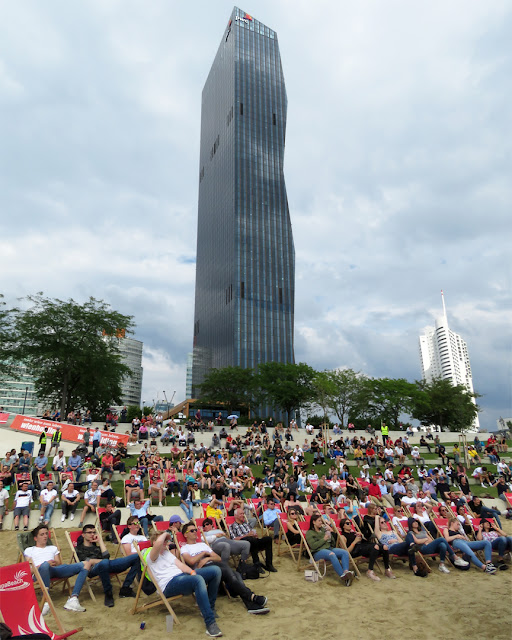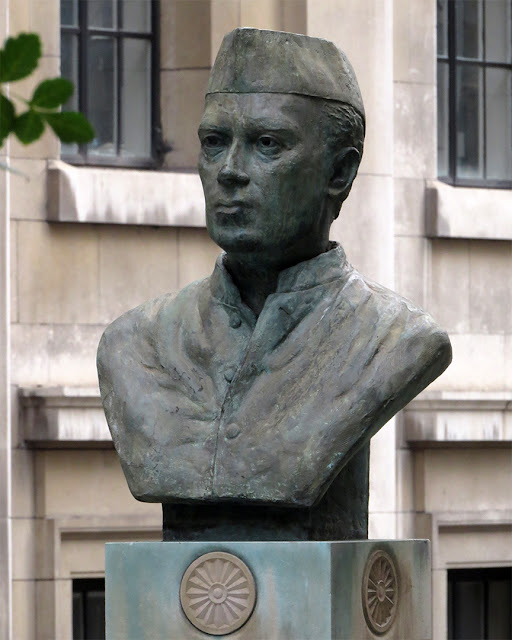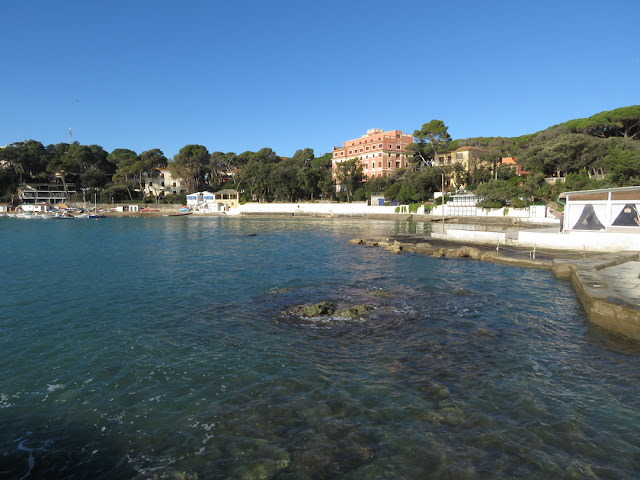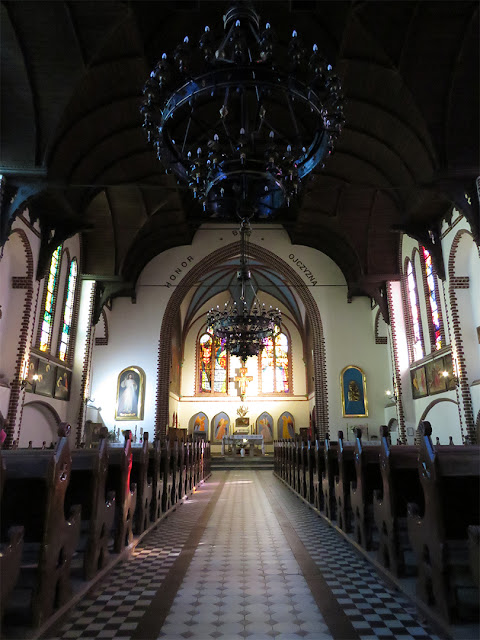Saturday, April 30, 2022
Homenatge a Picasso
“Homenatge a Picasso” (Tribute to Picasso) by Antoni Tàpies, 1981
Passeig de Picasso
Barcelona, March 2017
“In 1981, Antoni Tàpies was commissioned by Barcelona City Council to create a monument to Picasso, which was to stand at the junction of Passeig de Picasso and the pedestrian area that links the Santa Maria del Mar area with Ciutadella Park. To this end, the artist designed an assemblage of furniture in a modernista style-a piece of furniture that is a sofa, mirror and cupboard combined, cut through by iron beams painted white, that calls to mind the period that Picasso spent living in Barcelona-that suggest the industrial Barcelona of the time. The conformist nature of a well-to-do society and the rebellion of another society in the throes of change are contrasted, thereby alluding in a symbolic way to Picasso's non-conformism. Chairs piled on top of each other, tied together with ropes, white blankets laid out that carry quotations by Picasso at the bottom-in particular, the phrase that reads ‘a painting is not intended to decorate a drawing room but is instead a weapon of attack and defence against the enemy’, a declaration of principles that Tàpies adopts as his own in this monument and in his entire oeuvre-complete the work. A glass cube measuring 4 metres along each side covers the sculpture to protect it from the elements and seems to emerge from a square pool measuring 11 metres along each edge that acts as a base. Water emerges from the top of the cube and runs down its sides.” (Tribute to Picasso, Fundació Antoni Tàpies)
Friday, April 29, 2022
San Giovanni in Laterano
Arcibasilica di San Giovanni in Laterano (Archbasilica of Saint John Lateran)
Piazza di San Giovanni in Laterano
Rome, May 2010
“The Cathedral of the Most Holy Savior and of Saints John the Baptist and John the Evangelist in the Lateran (Italian: Arcibasilica del Santissimo Salvatore e dei Santi Giovanni Battista ed Evangelista in Laterano), also known as the Papal Archbasilica of Saint John [in] Lateran, Saint John Lateran, or the Lateran Basilica, is the cathedral church of the Diocese of Rome in the city of Rome, and serves as the seat of the bishop of Rome, the pope. The archbasilica lies outside of Vatican City proper, which is located approximately 4 kilometres (2.5 mi) to the northwest. Nevertheless, as properties of the Holy See, the archbasilica and its adjoining edifices enjoy an extraterritorial status from Italy, pursuant to the terms of the Lateran Treaty of 1929. The church is the oldest and highest ranking of the four major papal basilicas as well as one of the Seven Pilgrim Churches of Rome, holding the unique title of "archbasilica". Originally founded in 324, it is the oldest public church in the city of Rome, and the oldest basilica of the Western world. It houses the cathedra of the Roman bishop, and has the title of ecumenical mother church of the Roman Catholic faithful. The building deteriorated during the Middle Ages and was badly damaged by two fires in the 14th century. It was rebuilt in the late 16th century during the reign of Pope Sixtus V. The new structure's interior was renovated in the late 17th century, and its façade was completed in 1735 under Pope Clement XII. The current rector is Cardinal Archpriest Angelo De Donatis, Vicar General for the Diocese of Rome. The President of the French Republic, currently Emmanuel Macron, is ex officio the ‘First and Only Honorary Canon’ of the archbasilica, a title that the heads of state of France have possessed since King Henry IV. The large Latin inscription on the façade reads: Clemens XII Pont Max Anno V Christo Salvatori In Hon SS Ioan Bapt et Evang. This abbreviated inscription translates as: ‘Pope Clement XII, in the fifth year [of his Pontificate, dedicated this building] to Christ the Savior, in honor of Saints John the Baptist and [John] the Evangelist’. The inscription indicates, with its full title (see below), that the archbasilica was originally dedicated to Christ the Savior and, centuries later, co-dedicated to Saint John the Baptist and Saint John the Evangelist. Christ the Savior remains its primary dedication, and its titular feast day is 6 August, the Transfiguration of Christ. As the Cathedral of the Pope as Bishop of Rome, it ranks superior to all other churches of the Roman Catholic Church, including Saint Peter's Basilica.” (Archbasilica of Saint John Lateran, Wikipedia)
Thursday, April 28, 2022
Nowy Ratusz
Nowy Ratusz (New Town Hall)
Wały Jagiellońskie
Gdańsk, September 2018
“Known fondly by locals of a certain age today as ‘Żak’, this beautiful building which was renovated in the years after the turn of the century was originally built as the ‘Generalkommando’ (General Command) of the Prussian Garrison stationed in the city. Costing an eye-watering 6.2 million Marks the residence took three years to build (1898-1901) and incorporated an annex and stables all set in 1.8 hectares of parkland. The new Free City Parliament (Volkstag) wanted to take control of the building for its purposes but lost out to the League of Nations High Commissioner Sir Richard Haking and he forced the Volkstag out and commandeered it for himself. In 1938 Nazi Gauleiter Albert Forster famously promised C.J. Burkhardt (the last High Commissioner) that his residence would be turned into a casino for party dignitaries once they were rid of him although in fact it became the residence of General Max Bock and Lt. Col. Hans-Ludwig Grosser during the war. The end of the war saw the new Communist authorities take over the building but it was in the period 1957-1999 when a new legend was written for the building. The student club Klub Studentów Wybrzeża Żak or Żak for short became a cultural centre for the youth of the Tri-city as well as a hotbed of anti-communist thinking. Stars like the Polish James Dean Zbigniew Cybulski performed in the club’s theatre while the parties are reported to have been legendary. As well as performances the building featured one of the only cinemas showing independent films as well as a cafe and bar. As described by the students themselves ‘Żak was like a colourful island in a sea of gray: people banging doors and windows at all events, no matter what it was. That's when Żak was a legend.’ In 1991 the new independent city authorities, now staffed by many of Żak’s former members (Gdańsk City President Paweł Adamowicz is a self-confessed veteran) decided to create a new cultural centre here and for the next 8 years it presented music, theatre, film, exhibitions, workshops as well as becoming one of the best places to party in the entire city. The city took back the building in 1999 and returned it to its former glory turning it into the ceremonial Town Hall of the city. It honoured Irishman Sean Lester, the League of Nations' High Commissioner from 1934-37 by renaming one of the rooms in his honour in 2010. Żak, meanwhile, lives on in a new purpose built property on the main road between Wrzeszcz and Oliwa.” (New Town Hall, In Your Pocket)
Wednesday, April 27, 2022
Tuesday, April 26, 2022
Hotel Baia del Sorriso
Hotel Baia del Sorriso
Via Aurelia, Castiglioncello
Rosignano Marittimo, September 2020
“The ‘bay of smiles’ is what Baia del Sorriso means in Italian, and you can't help but smile when you see the wonderful view of the coast, the bay and the glistening blue sea from the hotel. Rising high above the sea lies this magnificent old building from which you have a beautiful view of the bay Baia del Quecetano, famous for its beach resorts.” (Hotel Baia del Sorriso, in-Italia)
Monday, April 25, 2022
Plac Teatralny
Teatr Wielki w Warszawie (Grand Theatre in Warsaw)
plac Teatralny, Śródmieście
Warsaw, September 2018
“Theatre Square (Plac Teatralny) is a major square in the Śródmieście district of Warsaw, Poland. It spans from the Great Theatre building to the Senatorska Street. The origins of the square date back to the beginning of the 19th century, when a small square was established in 1818. From 1825 to 1832 the Great Theatre building was constructed. When the city administration was relocated to the Jabłonowski Palace, the square became a centre of city life. Various patriotic demonstrations took place there, including at the time of the failed January Uprising and the Revolution of 1905. In September 1939, the civilian defense of the city was located in the city hall. During the Warsaw Uprising of 1944 the square witnessed heavy fighting between the Nazi German soldiers and the Home Army partisans. Most of the surrounding buildings were heavily damaged or completely destroyed. After the war several buildings were restored, excluding the pre-war city hall with its notable clock tower. It was rebuilt according to the original architectural plans only in the late 1990s.” (Theatre Square, Wikipedia)
Sunday, April 24, 2022
Evocació marinera
“Evocació marinera” (Evocation of Seafaring) by Josep Maria Subirachs, 1960
Plaça del Mar, Barceloneta
Barcelona, March 2017
“His leap into full-on abstraction—a development that, while well underway beyond Spain’s borders, represented nothing less than profanity to the tightly controlled, Neo-Classical aesthetic of Francoist Spain—came with Forma 212 (Form 212, 1957), the first abstract sculpture to be displayed publicly in Barcelona. It is installed outside Llars Mundet, close to Joan Brossa’s Visual Poem. Being fairly well out of the public eye, that sculpture ducked any polemic; so it was his second abstract work, Evocació marinera (Evocation of Seafaring), begun in 1958, which attracted the ire of the conservatives. The piece was originally sited in front of the Naval Authority—akin to kicking the hornet’s nest of the ageing Francoist dictatorship, so it was quickly moved to its current location. The piece is not meant to be a simple evocation of the sea, but of our seafaring past. Hence it aims to do more than just replicate marine motifs but rather pay tribute to human beings’ fight for survival in and dominance of this vital environment. So its spiked forms conjure ships’ prows, sails and peaking waves which threaten to break over fragile craft, while the sculpture’s surface texture recalls the degradation of bleached timbers, rotted by the elements.” (Controversy in every angle, Barcelona Free Art)
Saturday, April 23, 2022
Ettore e Andromaca
“Ettore e Andromaca” (Hector and Andromache) by Giorgio de Chirico, 1966 (copy)
Museo Carlo Bilotti
Viale Fiorello La Guardia
Rome, September 2019
Friday, April 22, 2022
National Stary Theatre
Narodowy Stary Teatr im. Heleny Modrzejewskiej (Helena Modrzejewska National Stary Theater)
Jagiellońska
Stare Miasto (Old Town)
Kraków, September 2018
“The Helena Modrzejewska National Stary Theater in Kraków (Polish: Narodowy Stary Teatr im. Heleny Modrzejewskiej) is one of the oldest public stages in Poland and a national institution of culture, first opened in 1781. It was named after renowned Shakespearean actress Helena Modrzejewska. The theater was created by Feliks Oraczewski, a member of the Polish Parliament (Sejm), and the actor Mateusz Witkowski. On October 17, 1781 the Cracow city authorities gave Witkowski permission to perform comedy under the condition that he pay fifty Polish zloty a month to the municipal treasury. In 1798, Jacek Kluszewski, the starosta of Brzeg, took over the theater and converted two of his own buildings the corner of Szczepański Square and Jagiellonian Street into its permanent home. The theatre is regarded as Poland's leading theatre. In 1997 Krystyna Meissner became the director. Her term here was difficult and the following year she left at the request of the actors. In 2016, the MICET Interactive Museum / Theater Education Center opened in the theater building's 13th century cellars.” (National Stary Theatre, Wikipedia)
Thursday, April 21, 2022
Young Dancer
“Young Dancer” by Enzo Plazzotta, 1988 (unveiled)
(bronze statue of Royal ballerina Katie Pianoff )
Broad Court, Covent Garden
London, September 2014
“Enzo Plazzotta (29 May 1921 – 12 October 1981) was an Italian-born British sculptor. Plazzotta was born in Mestre, near Venice, and spent his working life in London. He is best remembered for a fascination with and study of movement in bronze - the human form, horses, ballerinas, and for his female studies, many of which adorn London's streets. He died in London, aged 60.” (Enzo Plazzotta, Wikipedia)
See also: Jeté
Wednesday, April 20, 2022
Castello Pasquini
Castello Pasquini (Pasquini Castle)
Piazza della Vittoria, Castiglioncello
Rosignano Marittimo, January 2021
“Pasquini Castle dominates the town center of Castiglioncello, in the municipality of Rosignano Marittimo, and dates to 1889, when it was built on the request of Baron Lazzaro Patrone on property purchased from Diego Martelli, who was forced to sell his estate because of his disastrous financial condition. The castle, built to look like Palazzo Vecchio, replaced Diego Martelli’s old estate, made famous by numerous paintings from the Macchiaioli movement, while the farming lands were transformed into a park, designed according to the Romantic style of the era, to decorate and protect the privacy of the new residence.” (Pasquini Castle in Castiglioncello, VisitTuscany)
Tuesday, April 19, 2022
St. Barbara's Church
St. Barbara's Church
Długie Ogrody
Gdańsk, September 2018
“Despite numerous devastations caused by fires and the armies of Stefan Batory and Napoleon, it was rebuilt each time. The tower, which is 40 m in height, was added to the church only in the early 17th Century. Inside the tower, there are three red-bronze bells, given by the priests of the Diocese of Magdeburg. In 1945, as a result of the war, the gables collapsed, along with the upper part of the tower and the roof, and most of the roof in the northern chapels and arcades separating the aisles. The church was rebuilt only in 1956-1967. During reconstruction, the side aisle was taken apart, and the church lost its unique shape shown in the old illustrations and paintings. The interior was furnished with contemporary elements, accompanied by historical sculptures donated by the National Museum in Gdańsk. While admiring the interior, take a closer look at the modern stained glass located on the street side of the church, created by Barbara Massalska.” (St. Barbara’s Church in Gdańsk, Pomorskie Travel)
Monday, April 18, 2022
Sunday, April 17, 2022
Saint Mary Magdalene
Santa Maria Maddalena
Saint Mary Magdalene
Piazza della Maddalena
Rome, June 2019
“The interior consists of a single elliptical nave with chapels on the sides, a transept and a deep apse that integrate perfectly with the later Rococo decorations. On the counter-façade there is a an extraordinary 18th-century organ loft involving gilded wooden carving and allegorical statues in white stucco. The beatiful sacristy is a unique example of the Roman Barocchetto style made between 1738 and 1741, with wooden wardrobes and presses painted to resemble marble. The ceiling vault was frescoed by Girolamo Pesce.” (Church of Santa Maria Maddalena in Campo Marzio, Turismo Roma)
Saturday, April 16, 2022
Wodozbiór
Wodozbiór (Water Tower)
Ogród Saski (Saxon Garden)
Warsaw, September 2018
“In the northwest part of the Saxon Garden, is situated by the ornamental lake surrounded by willows. This classicist water tower in the shape of a Roman monopteros was modelled on the Temple of Vesta in Tivoli. It was designed in 1852 by the architect Henryk Marconi.” (Saxon Garden, Wikipedia)
Friday, April 15, 2022
Thursday, April 14, 2022
Wednesday, April 13, 2022
Ryszard Kukliński Monument
Ryszard Kukliński Monument by Czesław Dźwigaj and Krzysztof Lenartowicz
Plac Jana Nowaka-Jeziorańskiego
Kraków, September 2018
“Ryszard Kukliński is a very controversial figure in Poland. A colonel of the Polish People’s Army, Kukliński began, on his own initiative, to cooperate with US intelligence services during the Cold War. Motivated by his fear of the outbreak of WWIII and the potential annihilation of his homeland in such a conflict, between 1972 and 1981 Kukliński revealed tens of thousands of secret plans drafted by the Warsaw Pact, including a planned attack against NATO allies, to the CIA. With American assistance he and his family were able to escape from Poland right before the outbreak of martial law. In the eyes of some Poles Kukliński is a hero - a brave ally of the United States in a time when the entire leadership of the Polish Army was sold to the Soviets. To others, he is a traitor - a fact reflected by the numerous times his bust in Jordan Park has been vandalised. In 2014 a Polish film about Kukliński’s life was released, entitled Jack Strong, his CIA codename. This imposing, statement-making monument in front of Galeria Krakowska and the building of the old Kraków train station is perhaps just as controversial as its subject. Designed by Czesław Dźwigaj and Krzysztof Lenartowicz, the monument consists of a series of tipping stone blocks representing the Berlin Wall, and a broken, partially rusted steel arch soaring over them. Inscriptions on the stone blocks tell Kukliński's story in the context of the political climate of the time. Critics of the monument claim it is too abstract and does not suit the surrounding environment (on the latter point we're inclined to agree), while others have embraced the modernist style and thought-provoking aspects of this artpiece. We're in the camp of those who appreciate the aesthetic, but also the monument's readiness to confront a controversial subject and even educate people about it. Kraków was actually the first city to invite Kukliński back to Poland, making him an honourary citizen in 1998.” (Ryszard Kukliński Monument, In Your Pocket)
Tuesday, April 12, 2022
Sala Hipóstila
Sala Hipóstila or Sala de las Cien Columnas
Parc Güell (Park Güell)
Carmel Hill
Barcelona, March 2017
“Following the stairs you go through a large porch that have eighty-six columns that supports a large square. The roof is covered with brittle and white uniform, but it is not plain, is sinking between column and column. In the middle there are fourteen brittle, spread unevenly. In spaces where there is no brittle medallions. The columns are also covered with white brittle at the bottom. There is no column with a right angle respect the soil, anyone has the same inclination. But not only support for the square, also serve as drains, all the rainwater that collects the square, is filtered, going through the columns and go to a chamber that serves as a reservoir, under the room. Where it is stored. The porch had been thought as a market of the garden city, but was never opened, not even build. Above the porch is a square of sand enclosed by a bank of style completely Gaudínian, which is shaped like a snake and is completely covered with brittle. This place has good views over Barcelona.” (Nature square and the Hipostila room, Park Güell)
Monday, April 11, 2022
Saint Nicholas of Tolentino
San Nicola da Tolentino agli Orti Sallustiani
(Saint Nicholas of Tolentino in the Gardens of Sallust)
Via di San Nicola da Tolentino,
Rome, September 2019
“San Nicola da Tolentino agli Orti Sallustiani (Saint Nicholas of Tolentino in the Gardens of Sallust) is a church in Rome. It is one of the two national churches of Armenia. The church was built for the Discalced Augustinians in 1599, and originally dedicated to the 13th century Augustinian monk, St. Nicholas of Tolentino (also called San Niccolò or Nicolò da Tolentino). The interior was rebuilt 1614–1620 by Carlo Buti and Martino Longhi, supported by patronage by the Pamphilj family. The Milanese architect Francesco Buzio was also involved in the redesign. Starting in 1654, it was rebuilt by Giovanni Maria Baratta, one of the main pupils of Alessandro Algardi. In 1883, the church was given to the Pontifical Armenian College by Pope Leo XIII. The Armenian Catholic Church is in full communion with the Roman Catholic Church.” (San Nicola da Tolentino, Wikipedia)
Sunday, April 10, 2022
World Cup at CopaBeach
Watching a World Cup match at CopaBeach
Kagran / Donauinsel
Vienna, June 2018
“This is where you can find the real riviera feeling in Vienna…on a river. This area, situated just below the Reichsbrücke on either side of the river, hosts several beach bars and restaurants where you can drink and eat, and maybe even make a little sand castle in the sand when you get drunk and silly enough. The iconic Ponte Cagrana pontoon bridge connects the Copa beach with the Sunken City, which is an area hosting another series of restaurants on the shores of the Donauinsel. While plenty perceive this place as plain mainstream, attracting a (insert insulting words here) kind of crowd, the city is working at rejuvenating this riverside playground and one visit makes most realize this beautiful spot is underrated.” (Copa Beach on the Danube, Vienna Würstelstand)
Saturday, April 9, 2022
Jawaharlal Nehru
Bust of Jawaharlal Nehru by Latika Katt, 1991
India Place
India House, Aldwich
London, September 2014
“Jawaharlal Nehru (14 November 1889 – 27 May 1964) was an Indian politician, anti-colonial nationalist, secular humanist, social democrat, diplomat, journalist and author who was a central figure in India during the middle of the 20th century. Nehru was a principal leader of the Indian nationalist movement in the 1930s and 1940s. Upon India's independence in 1947, he served as the country's prime minister for 17 years. Nehru promoted parliamentary democracy, secularism, and science and technology during the 1950s, powerfully influencing India's arc as a modern nation. In international affairs, he steered India clear of the two blocs of the Cold War.” (Jawaharlal Nehru, Wikipedia)
Friday, April 8, 2022
The sea in winter
The sea in winter
Castiglioncello
Rosignano Marittimo, January 2021
“The Macchiaioli, a group of Italian artists active in Tuscany in the second half of the nineteenth century who had some points in common with the French Impressionists, chose Castiglioncello as an inspirational focus for their work. Macchiaioli painters who dedicated time to Castiglioncello included Giovanni Fattori, Silvestro Lega and Telemaco Signorini, among others.” (Castiglioncello, Wikipedia)
Thursday, April 7, 2022
Church of St. George
Kościół św. Jerzego (Church of St. George)
Bohaterów Monte Cassino
Sopot, September 2018
“The minimalist whitewashed interior comprises three unremarkable stone and brick naves, some charming modern stained glass and a wooden relief of the Virgin Mary by Zofia Kamilska-Trzcińska, which used to be on board the SS Batory as a token of luck during the war.” (Garrison Church of St. George, In Your Pocket)
Wednesday, April 6, 2022
Casa Batlló
Detail of the facade
Casa Batlló by Antoni Gaudí, 1909
Passeig de Gràcia
Barcelona, March 2017
“The façade has three distinct sections which are harmoniously integrated. The lower ground floor with the main floor and two first-floor galleries are contained in a structure of Montjuïc sandstone with undulating lines. The central part, which reaches the last floor, is a multicolored section with protruding balconies. The top of the building is a crown, like a huge gable, which is at the same level as the roof and helps to conceal the room where there used to be water tanks. This room is currently empty. The top displays a trim with ceramic pieces that has attracted multiple interpretations.” (Casa Batlló, Wikipedia)
Tuesday, April 5, 2022
Percy Bysshe Shelley
The grave of Percy Bysshe Shelley (1792–1822)
Cimitero acattolico (Non-Catholic Cemetery)
Via Caio Cestio
Rome, September 2019
“On 1 July, Shelley and Edward Williams sailed in Shelley's new boat the Don Juan to Livorno where Shelley met Leigh Hunt and Byron in order to make arrangements for a new journal, The Liberal. After the meeting, on 8 July, Shelley, Williams and their boat boy sailed out of Livorno for Lerici. A few hours later, the Don Juan and its inexperienced crew were lost in a storm. The vessel, an open boat, had been custom-built in Genoa for Shelley. Mary Shelley declared in her ‘Note on Poems of 1822’ (1839) that the design had a defect and that the boat was never seaworthy. In fact the Don Juan was overmasted; the sinking was due to a severe storm and poor seamanship of the three men on board. Shelley's badly-decomposed body washed ashore at Viareggio ten days later and was identified by Trelawny from the clothing and a copy of Keats's Lamia in a jacket pocket. On 16 August, his body was cremated on a beach near Viareggio and the ashes were buried in the Protestant Cemetery of Rome. The day after the news of his death reached England, the Tory London newspaper The Courier printed: ‘Shelley, the writer of some infidel poetry, has been drowned; now he knows whether there is God or no.’ Shelley's ashes were reburied in a different plot at the cemetery in 1823. His grave bears the Latin inscription Cor Cordium (Heart of Hearts), and a few lines of ‘Ariel's Song’ from Shakespeare's The Tempest:
Nothing of him that doth fade
But doth suffer a sea change
Into something rich and strange.
” (Percy Bysshe Shelley, Wikipedia)
Monday, April 4, 2022
Akademia Teatralna
Akademia Teatralna im. Aleksandra Zelwerowicza
(Aleksander Zelwerowicz National Academy of Dramatic Art)
Ulica Miodowa
Warsaw, September 2018
“The Aleksander Zelwerowicz National Academy of Dramatic Art in Warsaw (Polish: Akademia Teatralna im. Aleksandra Zelwerowicza) is a public higher education institution in Warsaw, Poland. Its focus is on the theatre arts. It is headquartered in the Collegium Nobilium, an eighteenth-century building which formerly housed an elite boarding secondary school run by Piarist monks. It was founded in Łódź in 1946 and moved to Warsaw in 1949.[1] It continues the tradition of the National Institute of Theatre Arts (Państwowy Instytut Sztuki Teatralnej) established in Łódź in 1932. It was founded as the National Higher School of Theatre (Państwowa Wyższa Szkoła Teatralna) and received a patron (Aleksander Zelwerowicz) in 1955. In 1962 it received certification as a higher education institution. It received its current name in 1996.” (Aleksander Zelwerowicz National Academy of Dramatic Art in Warsaw, Wikipedia)
Sunday, April 3, 2022
St Mary le Strand
St Mary le Strand
Strand
London, September 2014
“St Mary le Strand is a Church of England church at the eastern end of the Strand in the City of Westminster, London. It lies within the Deanery of Westminster (St Margaret) within the Diocese of London. The church stands on what was until recently a traffic island to the north of Somerset House, King's College London's Strand campus, and south of Bush House (now also part of King's College London). It is the official church of the Women's Royal Naval Service, and has a book of remembrance for members who have died in service. The nearest tube station is Temple, with the now-closed Aldwych station nearly opposite the church. It is known as one of the two 'Island Churches', the other being St Clement Danes.” (St Mary le Strand, Wikipedia)
Saturday, April 2, 2022
Bay of Quercetano
Bay of Quercetano
Lungomare del Quercetano, Castiglioncello
Rosignano Marittimo, September 2020
“Castiglioncello is a frazione of the comune of Rosignano Marittimo, in the province of Livorno, Tuscany, Italy. It stands on a promontory reaching out into the Ligurian Sea, surrounded by pinewoods and hills that fall right down to the sea forming cliffs, little inlets, coves and sandy beaches. The area was inhabited in Etruscan and Roman times, as attested by the presence of an ancient necropolis. The Medici Grand Dukes of Tuscany had a watch tower built here in the 17th century. Castiglioncello has been a renowned sea resort since the 19th century. People who made their homes here include Luigi Pirandello, Marcello Mastroianni, Luchino Visconti and Vittorio Gassman.” (Castiglioncello, Wikipedia)
Friday, April 1, 2022
Józef Piłsudski
Józef Piłsudski Monument by Czesław Dźwigaj, 2008
Józefa Piłsudskiego
Kraków, September 2018
“The idea to commemorate the statesman with a proper memorial was actually first put forward that same year, 1922. As it happened, the project was put on hold to focus on building the Józef Piłsudski House (al. 3 Maja 7), a commemorative modernist structure located on the spot from which the First Cadre Company, mobilised by Piłsudski, set out for Russia at the start of WWI. The building was completed in 1935, but before long WWII broke out in Europe and the memorial was delayed even more; by the time the war ended and the new communist government took over, any positive mention of Piłsudski was a no-no due to his anti-Russian and anti-communist views. All the while, pro-Piłsudski sentiment brewed among the Polish populace, and the fall of communism brought a renewed surge of commemorative efforts. Since 1989, two characters have started dominating the landscape, with monuments popping up left and right: our man Piłsudski and Pope John Paul II. This three-part statue, fittingly located on Piłsudski Street, was unveiled in 2008 thanks to the efforts of the local Marksmen’s Society, an organisation dating back to the 13th or 14th century, when their primary purpose was training civilians to be able to defend the city walls. Created by Czesław Dźwigaj, also responsible for churning out nearly fifty Pope John Paul II’s, the monument portrays a tall and intimidatingly mustachioed Piłsudski watching over four Polish Legions soldiers - apparently plagiarized from an earlier work by Jan Raszka. An 8.5m flag mast, wrapped with laurel foliage, completes the memorial.” (Józef Piłsudski Monument, In Your Pocket)
Subscribe to:
Posts (Atom)




